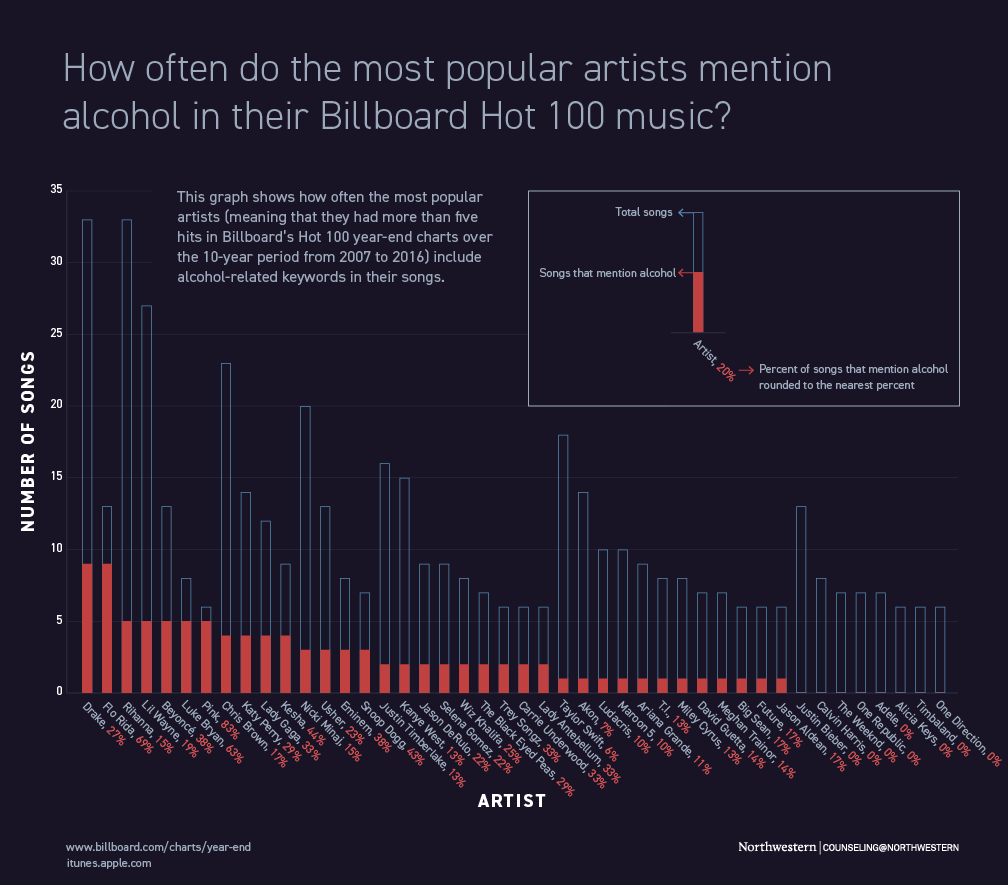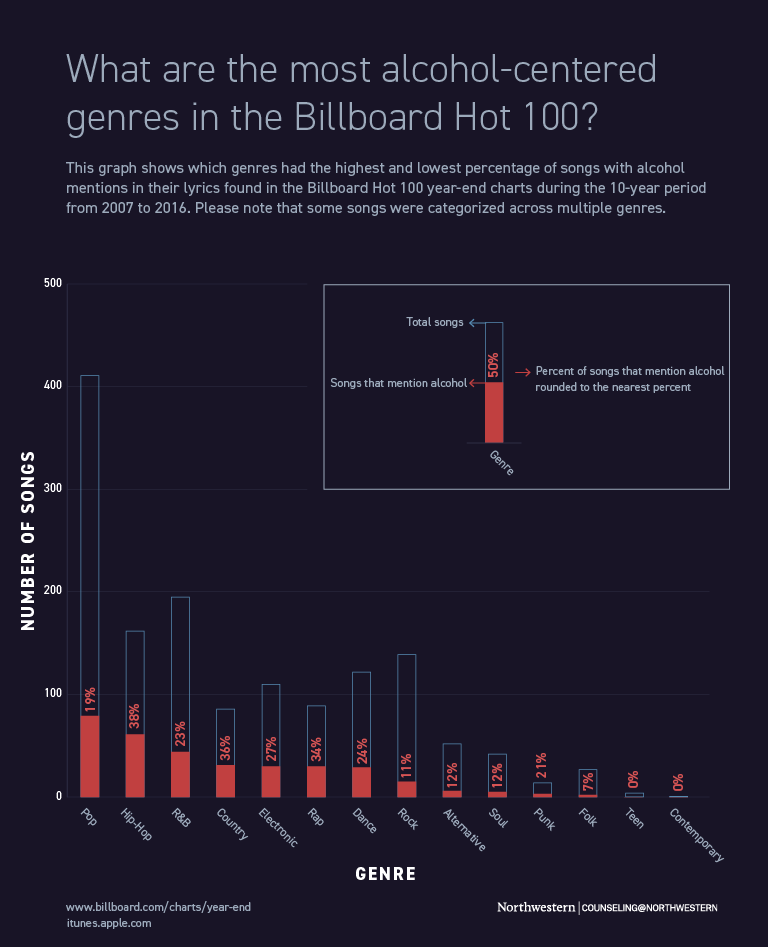Decade of Drunk Lyrics: A Look at How Often Pop Music Mentions Alcohol [Data Visualization]
View the text-only version of these infographics
Editor’s note: The data visualizations shown below were born out of a curiosity to see how often alcohol-related terms were mentioned in popular music. This is not a peer-reviewed research study, and no conclusions should be derived from this data without further research. This analysis does not include each artist’s full discography and only reflects the results of Billboard’s Hot 100 end-of-year charts for the 10-year period between 2007–2016.
The keywords were not analyzed for positive or negative sentiment, and the data simply demonstrates how often alcohol-related keywords were mentioned. Simply because an artist mentions alcohol within his or her lyrics does not necessarily mean that the lyrics are intended to promote its use; in fact, they might be intended to raise awareness of the dangers of its use. Conversely, just because an artist was not found to mention alcohol in his or her lyrics does not necessarily mean that the artist promotes sobriety. We hope that you find the results of the analysis as interesting as we have.
What do Drake, Pink, and Luke Bryan have in common? These artists have the most songs with at least one reference to alcohol in the Billboard Hot 100 year-end music charts.
From 2007 to 2016, an average of 22.4 percent of songs from Billboard’s Hot 100 year-end charts included one or more mentions of alcohol.
The Counseling@Northwestern marketing team crunched a decade of Billboard 100 data to investigate how often popular songs mention alcohol. We began our analysis by pulling Billboard’s Hot 100 songs year-end charts from 2007 to 2016 and looking at how often the lyrics of the songs mentioned alcohol-related keywords. The keywords we searched for included top alcohol brands, terms meaning types of alcohol, and terms that mean being under the influence of alcohol. For example, some of the most popular terms found in these lyrics included “Patrón,” “champagne,” and “drunk,” but the most popular term overall was “drink.” We then analyzed that keyword data by artist and genre, which we pulled from iTunes.
Our analysis found that from 2007 to 2016, an average of 22.4 percent of songs on Billboard’s Hot 100 year-end charts mentioned alcohol at least once. Though there were slight ebbs and flows, the frequency stayed relatively consistent across the 10-year period.
Take a closer look at the data by clicking on one of the following questions:
Methodology
Our analysis began with a list of 50 key terms that mean under the influence of alcohol, suggest alcohol use, or refer to alcohol directly. Once a key term was identified in a song, we took a closer look at the lyrics to identify additional key terms that could be used in relation to alcohol within the context of the song’s meaning.
All key terms were counted the first time they were used in a particular line or verse. Each term was counted only in the first instance in which it was mentioned in the lyrics because we looked to measure the ways in which alcohol-related messages are used within new contexts in the lyrics. We did not recount the same term within the same context twice so that terms repeated in later verses or choruses were not then added again to the final count.
We also contextualized the lyrics to ensure that each key term found was identified as related to alcohol directly. For example, if the term “drink” was found in a line related to a non-alcoholic beverage or in a context related to drug use, the term was not counted. Let’s look at the song “Like a G6” by Far East Movement as an example:

Figure 1.1 demonstrates the keyword breakdown of the “Like a G6” lyrics. Note that the line “drink-drink” was counted as two separate counts of the term “drink.”
“Like a G6” had the largest quantity of alcohol-related keywords with 14 keywords mentioned in unique lines of the song (meaning that they were not repeated verses or the chorus). This song highlights the importance of contextualizing each term. For example, the lyrics reference “sippin’ sizzurp,” and later “sippin’ on sizz,” but neither line is related to alcohol. According to genius and urban dictionary, these lines refer to the mixing of cough medicine or codeine syrup with sprite and jolly ranchers. Because the references were associated with drug use and not alcohol, they were not counted in our key terms.
Following “Like a G6,” the largest quantity of key terms related to alcohol were found in the songs “Drunk on a Plane” by Dierks Bentley with six keywords and “Drunk in Love” by Beyoncé with five keywords. Let’s take a deeper look at how often alcohol is mentioned when measured by artist or genre.
How often do the most popular artists mention alcohol in their Billboard Hot 100 music?

Figure 1.2 This graph shows how often the most popular artists (meaning that they had more than five hits in Billboard’s Hot 100 year-end charts over the 10-year period from 2007 to 2016) include alcohol-related keywords in their songs.
Artists whose Billboard 100 songs did not include any alcohol-related keywords include:
- Justin Bieber: 13 songs
- Calvin Harris: 8 songs
- One Republic: 7 songs
- One Direction: 6 songs
- Timbaland: 6 songs
- The Weeknd: 7 songs
- Adele: 7 songs
- Alicia Keys: 6 songs
Artists who had the most alcohol mentions in their Billboard Hot 100 music were:
- Drake: 9 out of 33 songs, 27.27%
- Flo Rida: 9 out of 13 songs, 69.23%
- Rihanna: 5 out of 33 songs, 15.15%
- Lil Wayne: 5 out of 27 songs, 18.51%
- Beyoncé: 5 out of 13 songs, 38.46%
- Luke Bryan: 5 out of 8 songs, 62.5%
- Pink: 5 out of 6 songs, 83.33%
Artists who had the highest concentrations of alcohol mentions in their Billboard Hot 100 music were:
- Pink: 5 out of 6 songs, 83.33%
- Flo Rida: 9 out of 13 songs, 69.23%
- Luke Bryan: 5 out of 8 songs, 62.5%
- Kesha: 4 out of 9 songs, 44.44%
- Snoop Dogg: 3 out of 7 songs, 42.85%
What are the most alcohol-centered genres in the Billboard Hot 100?

Figure 1.3 This graph shows which genres had the highest and lowest percentage of songs with alcohol mentions in their lyrics found in the Billboard Hot 100 year-end charts during the 10-year period from 2007 to 2016. Please note that some songs were categorized across multiple genres.
The five genres with the most alcohol-centered music (in order of highest percentage of alcohol mentions to lowest) were the following:
- Hip-Hop: 61 out of 162 songs, 37.65%
- Country: 31 out of 86 songs, 36.05%
- Rap: 30 out of 89 songs, 33.71%
- Electronic: 30 out of 110 songs, 27.27%
- Dance: 29 out of 122 songs, 23.77%
The five genres with the least alcohol-centered music (in order of the lowest percentage of alcohol mentions to the highest) were the following:
- Contemporary: 0 out of 1
- Teen: 0 out of 4
- Folk: 2 out of 27 songs, 7.40%
- Rock: 15 out of 139 songs, 10.79%
- Alternative: 6 out of 52, 11.53%
How do alcohol mentions in pop music influence use?
Pop culture plays a significant role in our lives. According to Albert Bandura’s social learning theory [PDF], individuals learn from personal experiences, and many are also influenced by modeled behaviors that they see in movies, TV shows, magazines, and music. That’s why the content promoted by popular culture is so influential.
This analysis was inspired by previous research that examined three years (2009–2011) of Billboard’s most popular song lists and found that alcohol use was overwhelmingly portrayed as positive. “Given the heavy exposure of youth to popular music, these results suggest popular music may serve as a major source of promotion of alcohol use among youth,” said a news release citing study co-author David Jernigan, PhD, director of Boston University’s Center on Alcohol Marketing and Youth (CAMY). Another team of researchers analyzed substance use in contemporary popular music and found that “the average adolescent is exposed to approximately 84 references to explicit substance use daily in popular songs.” Both teams of researchers agree that young people are influenced by popular music.
According to Eric Beeson, faculty member in Northwestern’s online master’s in counseling program, pop culture may not cause people to drink, but it can foster and increase substance use due to socio-cultural factors. Beeson says that it’s important to consider “what drives this individual in their substance use.” For example, he suggests that if someone is motivated by “esteem, power, money, respect, and sexual relationships,” and those things are often associated with using drugs or alcohol in pop music, then they may be motivated to use those substances.
Popular musicians play a role in socializing what is and isn’t cool for young people. Although their work might exacerbate substance use in young adults, artists also have the power to influence positive behaviors.
Demi Lovato is an example of an artist who struggled with substance addiction and mental health and is now a well-known advocate for substance recovery. Lovato’s positive influence reaches her more than 56 million followers on Instagram and another 42.5 million followers on Twitter. She shares her personal experiences in an effort to inspire young people to develop healthy habits with substances and their bodies.
Calvin Harris has also spoken openly about his sobriety in the past and is known for music that avoids the topic of substance use. His healthy stance on substance use serves as a positive influence for a wide audience of 8.5 million followers on Instagram and 10 million followers on Twitter. The Billboard Hot 100 year-end data that we analyzed is consistent with his public stance on alcohol; in the 10-year period, Harris didn’t mention a single alcohol-related term in his most popular songs.
Although a good number of popular artists mention alcohol and other substances in their music, artists like Harris serve as a reminder that songs can be popular and successful without having to rely on promoting alcohol.
However, it’s also important to note that if artists mention alcohol in their music, it doesn’t necessarily mean that their intention is to promote its use. Hip-hop artist Kendrick Lamar is an example of an artist whose music can be misconstrued. Lamar abstains from substance use, but his song “Swimming Pools (Drank)” is often viewed as a popular college party anthem. Lamar dispels the misconception in an interview with Complex in which he explains that the lyrics are actually about the peer pressure to drink. In the article, Lamar says, “I’m coming from a household where you had to make a decision—you were either a casual drinker or you were a drunk. That’s what that record is really about, me experiencing that as a kid and making my own decisions.”
For that reason, contextualizing the lyric is important. The fact that young adults may drink to songs whose lyrics discuss the pressure to drink begs the question: Does the mere mention of alcohol, regardless of its intention, affect the listener just the same?

